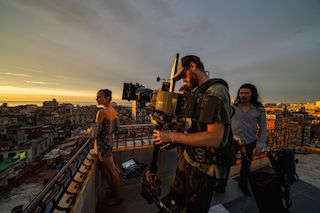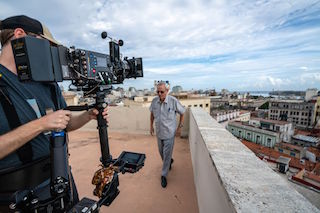 Cinematographer Peter Chang has completed his latest film, Cuba, which won the Best Documentary award at the 34th Annual Fort Lauderdale International Film Festival and has begun releasing to museums, educational institutions and other giant screen and IMAX venues. In a break from giant screen tradition, his film features close-ups. To accomplish that, he turned to Cooke lenses.
Cinematographer Peter Chang has completed his latest film, Cuba, which won the Best Documentary award at the 34th Annual Fort Lauderdale International Film Festival and has begun releasing to museums, educational institutions and other giant screen and IMAX venues. In a break from giant screen tradition, his film features close-ups. To accomplish that, he turned to Cooke lenses.
Chang, who is known for his work on such films as Jerusalem and America Wild: National Parks Adventure, had first used the Cooke S7/I large format lenses on a project in early 2018, having tested them for giant-screen use on that project. Based on those results, they became frequently used lenses on the final and mostly narrative centric shoot in Cuba — the personal stories – while breaking with the IMAX and giant-screen standard of avoiding close-ups.
“Cuba is focused on the beauty, spirit and character of this Caribbean country and its people,” said Chang. “One of the primary stories in the film centers around a young ballerina. I was really looking forward to using the Cookes as we knew we would be shooting on stage with challenging theatrical stage lighting, and breaking that sort of giant screen IMAX norm of not having any close-ups. That’s exactly what we did — shot some close-ups of her face, which came out beautifully.”
There are, however, challenges in shooting close-ups in terms of framing for such a large image, based on how it is projected.
“IMAX has flat screens that are typically used for 3D, and you also have dome theatres where you’re looking at the bottom half of a 1.43 image and then the rest of it is over your head and you’re not typically looking at that,” explained Chang. “A close-up has to be framed in that bottom half or third of the image. With an image as big as we’re projecting – at times, 90 feet x 65 feet or more – a close-up can be rather jarring because you can see a lot of the imperfections on people’s faces, you can see the makeup on their skin and blemishes that can be unattractive, but I wanted to see how far we could push it with our ballerina to gain more intimacy.”
 Chang, and his co-DP Justin Henning, had the full set of 12 lenses at their disposal, though they primarily used the 18mm. “I teamed the Cooke S7/i lenses with the Arri Alexa LF camera, which is a phenomenal combination,” said Chang. “It gives me a very cinematic and dreamy look — very smooth and gentle, but still crisp and sharp. Cooke lenses have always been very flattering with faces and people, so for the portrait-oriented sections of the film this pairing was magical.”
Chang, and his co-DP Justin Henning, had the full set of 12 lenses at their disposal, though they primarily used the 18mm. “I teamed the Cooke S7/i lenses with the Arri Alexa LF camera, which is a phenomenal combination,” said Chang. “It gives me a very cinematic and dreamy look — very smooth and gentle, but still crisp and sharp. Cooke lenses have always been very flattering with faces and people, so for the portrait-oriented sections of the film this pairing was magical.”
The Cooke S7/i primes were also a great choice for Henning. “The lenses were very sharp, something extremely important at the resolutions and IMAX screens we are shooting for, while maintaining a creamy bokeh and very pleasant roll off,” he said. “What I loved most about shooting the Cooke S7/i lenses is the familiarity that they gave me. I’ve shot on Cooke lenses for years, starting with the Speed Panchro, then the S4/i lenses and most recently a lot with the new Cooke SF [Special Flair] Anamorphic/i. Cooke lenses have always been a go-to for me. On Cuba I had the pleasure to shoot on the Alexa LF in full frame for the first time, and the fact that the Cooke S7/i lenses maintained the ‘Cooke Look’ that I have grown accustomed to over the years was great — but on this new full frame camera system, it was a real treat.”
“I really love the way these lenses flare, an important consideration for any lens. In challenging backlit situations shooting into the sun, the flare is beautiful and natural, bringing added dimensionality, and I tried to exploit that with these lenses during shooting, like when the ballerina trains on the beach as the sun is setting,” said Chang.
With a wide release scheduled for 2020, Cuba is shaping up to be one of the most anticipated IMAX and giant screen releases. The film was recently selected as the opening night film for the Fort Lauderdale International Film Festival, where it received great reviews, including from members of the large Cuban American population of south Florida. It is primarily available with a 44-minute run time, but a 20-minute version has been made available for a select number of venues.
 “I’ve been working on this project since December 2014,” said Chang. “It’s a good timeframe to embrace all the new technologies available. We used a total of 18 different digital camera formats in the capture of this film.”
“I’ve been working on this project since December 2014,” said Chang. “It’s a good timeframe to embrace all the new technologies available. We used a total of 18 different digital camera formats in the capture of this film.”
Chang’s use of the Cooke S7/i lenses for the character scenes did, in fact, pay off as a part of what makes Cuba such an engaging film for audiences.
“For portraits and beauty shots the lenses worked incredibly for us,” said Henning. “The lenses are slightly warmer than other comparable lenses, which makes the skin tones look gorgeous. Because we were shooting for IMAX our lensing was typically very wide — usually around 18mm. But the combination of the Alexa LF and the S7/i lenses gave us a nice separation between our subjects and backgrounds. The IMAX format thrives on the environment that surrounds your subject. It is an incredibly immersive format. The trees over their head, the buildings that flank them on either side as they walk down the street — these things are all a secondary character in the film. Balancing the intimacy of character and the surrounding environment is one of the main challenges shooting for IMAX. The patina of Havana and the extra warmth of the Cooke lenses paired really nicely together.”
“On IMAX and giant screens, the Cooke images hold up really well — both in terms of image quality and emotional impact,” said Chang. “Audiences have cried when seeing our more emotional scenes. The combination of characters, stories, setting, music...everything comes together for Cuba, and Cooke was an important part of that.”
To learn more about Cuba, visit www.cuba-film.com.
